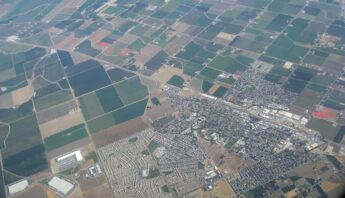As another spring planting season nears in California, I'm beginning to worry. Not just about the rain, but about all the kids and communities who could be harmed by pesticides drifting from agricultural fields. These same chemicals — year after year — end up as pesticide residues on our food.
Chlorpyrifos is one of these worrisome pesticides. The California Department of Pesticide Regulations or DPR has taken barely any action on this brain-harming chemical. Today, a group of public health and environmental groups are sending a letter to DPR officials urging them to stop stalling, and act to protect California’s kids today. Please join us in urging DPR to move!
Back in 2001, chlorpryifos products were banned from use in the home due to impacts on children's brains. There's plenty of scientific evidence on the harms of chlorpyrifos to children — and to California communities.
High use, high exposure
Over a million pounds of chlorpyrifos are used in California every year on crops such as citrus, grapes, broccoli, almonds and many others. Children who are exposed to chlorpyrifos before birth are more likely to have low birth weight and more likely to score poorly on tests of intellectual development.
Children and communities in rural areas are exposed to chlorpyrifos both through drift from applications to fields, and from residues on food.
Chlorpyrifos was the most frequently detected pesticide in DPR’s own recent air-monitoring data in rural areas of the state. Members of a group based in the Central Valley of California, El Quinto Sol de America, tested for chlorpyrifos near their homes abutting citrus groves and found the pesticide in the majority of samples in the air and in their bodies.
The Director of El Quinto Sol, Irma Arrollo, describes the problem this way:
"California communities on the frontlines of exposure deserve better protections. The problem lingers and neurotoxic pesticides continue to be sprayed around our communities with few safeguards."
Inaction in high places, innovation on the ground
Groups across the state are calling on DPR to move on all the strong evidence of both harm and exposure — and not wait for still more reviews. DPR opened up a review of chlorpyrifos back in 2004 but decided not to move ahead with it, instead relying on EPA’s review of chlorpyrifos at the national level.
From past experience this will likely take years, while kids keep getting exposed and harmed.
EPA's review will take years, while kids keep getting harmed.
DPR argues that defering to EPA is efficient, and cuts costs. This doesn’t hold much water, since agriculture in California is pretty different than other parts of the country, with a high proportion of labor-intensive crops on which chlorpyrifos is applied. This increases the chances of farmworker and community exposure.
And farms and communities are often close to each other in California, increasing the chances of people getting exposed to chlorpyrifos drift. Certain application methods — such as aerial applications and air blasting — are particularly hazardous, exposing ever larger numbers of people to this harmful pesticide.
And the thing is, innovations on farms and universities across the state has meant that for many crops, farmers have the ability to bypass this pesticide altogether. California needs to invest in developing safer alternatives to chlorpyrifos for the few crops for which effective options have not yet been found.
This state has always been a leader in the field of protecting the environment and its people from toxic chemicals, and we urge DPR and the government of California to act fast to protect children and communities from chlorpyrifos.
Photo credit: IS_ImageSource/iStock







